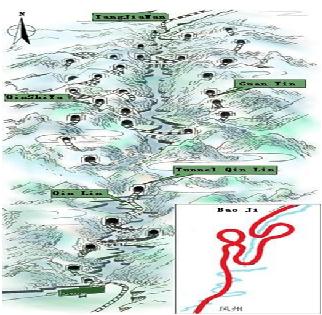当前你的浏览器版本过低,网站已在兼容模式下运行,兼容模式仅提供最小功能支持,网站样式可能显示不正常。
请尽快升级浏览器以体验网站在线编辑、在线运行等功能。
3677:Hard Rode
题目描述
The road to Shu is hard, even harder than climbing to the blue sky. A poem by Li Po from Tang Dynasty 1,200 years ago described the difficulty in travelling into Sichuan.

However the above old saying is no longer true as a convenient communication network of railway, highway, waterway and air transport has come into being. Railways cover a total mileage of 2,693 km, consisting of five trunk lines including the BaojiChengdu and Chengdu-Chongqing railways, eight feeder lines and four local railways. The total mileage of highways stretches to nearly 80,000 km, ranking at the forefront in China. Now a highway network with the provincial capital of Chengdu as the center radiating to all cities in the province has been formed. A total of 500 km of expressways have been built. It is very easy to transfer passengers and freights between Sichuan and other provinces. After a nationwide railway speed acceleration launched in last year, trains can be allowed to run at a speed above 120 km per hour. However, the average speed of a train depends on its make-up. There is only single railway track between stations from Baoji to Chengdu, A primary task for dispatchers is to arrange for trains to meet and pass each other. You are requested to write a program to make the arrangement for a series of trains of different speeds from one station to its next station in the least amount of time.
What you should pay attention to while writing this program is that since there is a single railway track from Baoji to Chengdu, two trains are not allowed to pass the same spot at the same time, or they would be collision, and that because of the limited staff, there should be a fixed interval time between two trains out of the station, what's more, the trains could pull into the station at the same time, but never get out at the same time.

However the above old saying is no longer true as a convenient communication network of railway, highway, waterway and air transport has come into being. Railways cover a total mileage of 2,693 km, consisting of five trunk lines including the BaojiChengdu and Chengdu-Chongqing railways, eight feeder lines and four local railways. The total mileage of highways stretches to nearly 80,000 km, ranking at the forefront in China. Now a highway network with the provincial capital of Chengdu as the center radiating to all cities in the province has been formed. A total of 500 km of expressways have been built. It is very easy to transfer passengers and freights between Sichuan and other provinces. After a nationwide railway speed acceleration launched in last year, trains can be allowed to run at a speed above 120 km per hour. However, the average speed of a train depends on its make-up. There is only single railway track between stations from Baoji to Chengdu, A primary task for dispatchers is to arrange for trains to meet and pass each other. You are requested to write a program to make the arrangement for a series of trains of different speeds from one station to its next station in the least amount of time.
What you should pay attention to while writing this program is that since there is a single railway track from Baoji to Chengdu, two trains are not allowed to pass the same spot at the same time, or they would be collision, and that because of the limited staff, there should be a fixed interval time between two trains out of the station, what's more, the trains could pull into the station at the same time, but never get out at the same time.
输入解释
The input consists of several test cases. Each test case begins with a line containing 3 integers L (1<=L<=100000) , N (1<=N<=8) and T (1 < T < 10000) which indicate the distance between two stations (unit is meter), the number of trains, as well as the interval time of adjacent trains when trains leave the start (unit is second).
The next N lines contain average speeds of N trains (unit is m/s).
A single line with L = 0 indicates the end of input file and should not be processed by your program.
The next N lines contain average speeds of N trains (unit is m/s).
A single line with L = 0 indicates the end of input file and should not be processed by your program.
输出解释
For each test case, your output should be in one line with the minimum time(round to integer) needed by the trains pulling into the terminal as indicated in the sample output.
输入样例
100000 6 300 3 4 5 6 2 1 0
输出样例
Case 1: 101500
来自杭电HDUOJ的附加信息
| Recommend | lcy |
最后修改于 2020-10-25T23:05:52+00:00 由爬虫自动更新
共提交 0 次
通过率 --%
| 时间上限 | 内存上限 |
| 2000/1000MS(Java/Others) | 32768/32768K(Java/Others) |
登陆或注册以提交代码